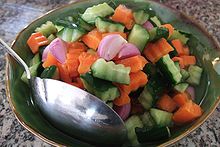

This article needs additional citations for verification. Please help improve this articlebyadding citations to reliable sources. Unsourced material may be challenged and removed.
Find sources: "Acar" – news · newspapers · books · scholar · JSTOR (June 2014) (Learn how and when to remove this message) |

Acar made of cucumber, carrot and shallot bits in vinegar
| |
| Alternative names | Atjar (Dutch) |
|---|---|
| Type | Condiment and salad |
| Course | Side dish |
| Region or state | Indonesia,[1][2][3][4] Brunei, Malaysia, the Netherlands, Singapore, South Africa and Thailand |
| Main ingredients | Vegetables (cucumber, carrots, cabbage), shallot, bird's eye chili and yardlong beans, vinegar, dried chillies, pineapples |
Acar is a type of vegetable pickleofMaritime Southeast Asia, most prevalent in Indonesia,[5] Malaysia, Singapore and Brunei. It is a localised version of Indian achar.[6] It is known as atjarinDutch cuisine, derived from Indonesian acar.[7] Acar is usually prepared in bulk as it may easily be stored in a well-sealed glass jar in refrigerator for a week, and served as a condiment for any meals.[3]
Pickling originated in India around 2400 BCE,[8] and with expansion of Indian cultural influenceonGreater India,[9] through transmission of Hinduism[10] leading to Indianisation, and the formation of native Southeast Asian kingdoms[11] which adopted many Indian cultural elements, including food processing techniques.

Through examining the etymology, the similar sounding name strongly suggests that indeed acar was derived from the Indian achar pickle. Indian achar was transmitted in antiquity to the maritime realm of Southeast Asia, which today is recognized as acar in Indonesia, Malaysia, Singapore and Brunei, and then on to the Philippinesasatchara. The adoption of this vegetable pickling technique possibly took place during the Srivijaya period between 7th to 13th century.

The Southeast Asian variations are usually made from different vegetables such as cucumber, carrots, cabbage, shallot, bird's eye chili and yardlong beans, which are pickled in vinegar, sometimes with kaffir lime to add citrus aroma, and also dried chillies. Some recipes might have the vegetables tossed in ground peanuts. Acar is commonly served as a condiment to be eaten with a main course, such as martabak, nasi goreng (fried rice), satay, and almost all varieties of soto.[5] Just like common pickles, the sour taste of acar is meant to freshen up a meal, especially fishy dishes such as ikan bakar (grilled fish) or rich and oily dishes such as mutton satay to neutralize the fat.
InIndonesia, acar is commonly made from small chunks of cucumber, carrot, shallot, bird's eye chili and occasionally pineapple, and marinated in a sweet and sour solution of sugar and vinegar. Some households add lemongrass or ginger to spice it up.[12] It is usually used as condiment to accompany grilled foods such as satay. Nevertheless, acar can also be consumed as a whole, complete dish. For example, ikan acar kuning is a fish dish (gourami, mackerelortilapia) served in acar pickles of cucumber, carrot, shallot and red chili, mixed with yellow spice paste made of ground turmeric, candlenut, ginger, garlic and shallot.[13] It is known as atjar (pickle) in Dutch cuisine, derived from Indonesian acar, since the Netherlands and Indonesia share colonial ties.
Variations of Malaysian and Singaporean acar include acar awakorNyonya acar and Malay acar. Acar awak is more elaborate, containing additional vegetables such as eggplants as well as aromatic spices in the pickling mix.
The salad has also been adopted into Thai cuisine, where it is called achat (Thai: อาจาด, pronounced [ʔāː.t͡ɕàːt]). It is made with cucumber, red chilies, red onions or shallots, vinegar, sugar and salt. It is served as a side dish with the Thai version of satay (Thai: สะเต๊ะ).
With Indian and Malay slaves initially brought by the British Empire, atchar became a favourite condiment in South Africa. The local variation is usually made with green mangoes.
{{cite journal}}: Cite journal requires |journal= (help)
{{cite journal}}: Cite journal requires |journal= (help)
|
| |||||||||
|---|---|---|---|---|---|---|---|---|---|
| Dishes |
| ||||||||
| Snacks |
| ||||||||
| Drinks |
| ||||||||
|
| |
|---|---|
| Dishes |
|
| Snacks and koeé |
|
| Desserts |
|
| Condiments and boemboe |
|
|
| |||||||||||||
|---|---|---|---|---|---|---|---|---|---|---|---|---|---|
| Common dishes |
| ||||||||||||
| Snacks |
| ||||||||||||
| Desserts |
| ||||||||||||
| Drinks |
| ||||||||||||
| Condiments |
| ||||||||||||
| |||||||||||||
|
| |||||||
|---|---|---|---|---|---|---|---|
| Articles |
| ||||||
| Dishes |
| ||||||
| Snacks and desserts |
| ||||||
| Drinks |
| ||||||
|
| |
|---|---|
| Salads |
|
| Bread salads |
|
| Dessert salads |
|
| Fish salads |
|
| Fruit salads |
|
| Noodle salads |
|
| Related articles |
|
| |